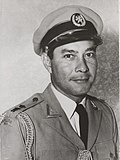Arab Indonesians
Arab Indonesians are citizens of Indonesia. Their origin is Arab, and they are mainly from Hadrami. Until 1919, they were part of Dutch East Indies' law. Some people later gained economic power through real estate investment and trading. Currently, most of them can be found in Java and South Sumatra. They are almost all (generally orthodox) Muslims.
 Hadhrami immigrants in Dutch East Indies | |
| Total population | |
|---|---|
| Regions with significant populations | |
| North Sumatra, Aceh, West Sumatra, South Sumatra, Jakarta, West Java, South Kalimantan | |
| Languages | |
| Indonesian, Arabic, Indonesian regional languages | |
| Religion | |
| mostly Sunni Islam with small Shia minority | |
| Related ethnic groups | |
| Hadhramis, Arab Singaporeans, Arab Malaysians, Arab diaspora |
History
Indonesia has had contact with the Arab world for hundreds of years. This was even before the development of Islam in Indonesia. Most contact was with spice traders. The first Arab settlements in the archipelago may have started in the fifth century. These early communities took over much of the local culture. Some of them disappeared completely while others formed ethnic groups.[3]
Modern Arab Indonesians are descended from Hadramis, who came to Indonesia during the Dutch colonial period. The men often married native women.[4][5] They were classified as "foreign orientals" along with Chinese Indonesians. This class stopped them from going to certain schools and also restricted their travel. They were also only allowed to live in special Arab districts, called kampung Arab in Indonesian. These laws were removed in 1919.[6]
The community elites began to build economic power through trade and real estate investment. They bought large amounts of real estate in Batavia (modern-day Jakarta), Singapore and other parts of this area. Arab Indonesians did charity work, and built and protected their social capital. Eventually, some Arab Indonesians joined the Volksraad, the people's council of the Dutch East Indies.[7]
During the Indonesian National Awakening, Arab Indonesians began to oppose native Indonesians and the Dutch. This caused the formation of organizations which were only for Arab Indonesians in 1913. These organizations viewed the Arabian peninsula as their homeland. In 1934, Abdurrahman Baswedan founded an Arab Indonesian nationalistic movement, Persatoean Arab Indonesia.[8]
Azyumardi Azra described Arab Indonesians as people who wish to remove local religious elements from Indonesian Islam. Indonesian critics of Arab influence in Indonesia point to the founding of the radical group Jemaah Islamiah (JI). Their leader is Laskar Jihad (LJ).[9][10] After the September 11 attacks on the World Trade Center in 2001 and the 2002 Bali bombing, the community came under suspicion.[3]
Identity
First generation immigrants are called wulāytī or totok. They are a small minority of the Arab Indonesian population. The majority, muwallad (plural form: muwalladīn), were born in Indonesia and may be of mixed heritage.[11]
Distribution
The majority of Arab Indonesians live on Java, mostly in East Java. Some live in South Sumatra.[12]
Religion

Arab Indonesians are almost all Muslim. According to the 2000 census, 98.27 percent of Arab Indonesians are Muslim, compared to 88.22 percent of the whole population. Historically, most have lived in kauman, or the area around mosques, but this has changed in recent years.[13] The majority are Sunni, people who follow the Shafi'i school of Islamic law. The Shia are a growing minority.[14] Children are often sent to madrasahs.[15]
The Islam practiced by Arab Indonesians is more orthodox than the local, indigenous-influenced forms like abangan. Many Arab Indonesians try to convince local Muslims to follow a more orthodox form of Islam as well.[9]
Notable Arab Indonesians
- Ali Alatas, former Minister of Foreign Affairs[16]
- Abdurrahman Baswedan, founder of Persatoean Arab-Indonesia[16]
- Abu Bakar Bashir, suspected head of Jemaah Islamiyah[16]
Arab Indonesians Media
The Ampel Mosque at the end of a shopping street in the Arab quarter of Surabaya, January 14, 1927
Women of Hadhrami descent in Palembang in 1940s
Anies Baswedan, former governor of Jakarta
Syarif Hamid Alkadrie, Arab-Indonesian Sultan of Pontianak in Borneo, 1950.
Kapten Arab of Tegal, Central Java
Arab Indonesian from Surabaya
References
- Footnotes
- ↑ Suryadinata, Leo (2008). Ethnic Chinese in Contemporary Indonesia. Singapore: Chinese Heritage Centre and Institute of Southeast Asian Studies. ISBN 978-981-230-835-1.
- ↑ Shihab, Alwi (2003-12-21). "Hadramaut dan Para Kapiten Arab". Republika. Retrieved 2015-03-25.
- ↑ 3.0 3.1 Cribb & Kahin 2004, pp. 18–19.
- ↑ Jacobsen 2009, p. 20.
- ↑ Fealy 2004, pp. 109–110.
- ↑ Jacobsen 2009, p. 54.
- ↑ Freitag 2003, pp. 237–239.
- ↑ Jacobsen 2009, pp. 54–55.
- ↑ 9.0 9.1 Diederich 2005, p. 140.
- ↑ Fealy 2004, pp. 109-110.
- ↑ Jacobsen 2009, pp. 21-22.
- ↑ Suryadinata 2008, p. 32.
- ↑ Suryadinata 2008, pp. 29-30.
- ↑ Jacobsen 2009, p. 19.
- ↑ Jacobsen 2009, p. 21.
- ↑ 16.0 16.1 16.2 Cribb & Kahin 2004, pp. 18-19.
- Bibliography
- Cribb, Robert; Kahin, Audrey (2004). Historical Dictionary of Indonesia. Historical dictionaries of Asia, Oceania, and the Middle East. Lanham, Maryland: Scarecrow Press. ISBN 9780810849358.
- Diederich, Mathias (2005). "Indonesians in Saudi Arabia: Religious and Economic Connections". In Al-Rasheed, Madawi (ed.). Transnational Connections and the Arab Gulf. London: Rutledge. pp. 128–146. ISBN 9780203397930.
- Fealy, Greg (2004). "Islamic Radicalism in Indonesia: The Faltering Revival?". Southeast Asian Affairs. Singapore: Institute of Southeast Asian Studies. 2004: 104–124. doi:10.1355/SEAA04H. ISBN 9789812302397. ISSN 0377-5437. S2CID 154594043.
- Freitag, Ulrike (2003). Indian Ocean Migrants and State Formation in Hadhramaut: Reforming the Homeland. Leiden: Brill. ISBN 9789004128507.
- Jacobsen, Frode (2009). Hadrami Arabs in Present-day Indonesia : an Indonesia-oriented Group with an Arab Signature. London: Routledge. ISBN 9780415480925.








